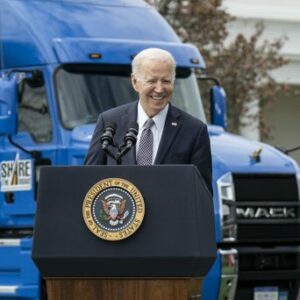Members of America’s trucking industry say stringent new federal regulations on emissions are largely unnecessary and could impact the nation’s already shaky supply chain. That’s particularly problematic in a state like New Hampshire where more isolated, rural communities are more reliant on over-the-road trucking for goods like food and fuel, and a trucker shortage is already at hand.
The Environmental Protection Agency announced late last month it had finalized new rules on restricting tailpipe emissions on large diesel trucks beginning in the model year 2027. The agency, which had been considering two options to address nitrous oxide (NOx), chose the more aggressive one. According to the EPA, the choice was between reducing emissions by 60 percent by 2045 and reducing them by 47 percent.
But according to transportation industry experts, the choice is between realistic goals and extreme mandates that are very expensive, will hurt the trucking industry, and are nearly impossible to reach.
Former Trump EPA Chief Of Staff Mandy Gunasekara told InsideSources she supports the EPA’s goal, and she said the Trump administration sought to do the same through its “Cleaner Trucks Initiative.” However, the Biden administration is going too far, too fast.
“The idea was to integrate new technologies that exist today and have evolved that could significantly reduce the emissions,” says Gunasekara, now a senior policy analyst with the Independent Women’s Forum (IWF) and a visiting fellow at The Heritage Foundation. “Now, what’s happened in the Biden administration is they want to crank it up and they want to set standards that are very difficult to meet.”
Jed Mandel, president of the Truck Engine Manufacturers Association, was more direct. “We are fundamentally opposed to Option 1,” Mandel told the trade publication Transportation Topics. “It’s not technologically feasible or cost-effective and truly not needed for the balance of the country.”
New Hampshire’s transportation system has been dealing with a shortage of trucks and drivers for years. Between 2019 and 2021, the number of Granite Staters with commercial driver licenses fell from 32,510 to around 29,000. The Sununu administration invested $4.6 million to support the state’s trucking industry.
Jasen Stock, executive director of the New Hampshire Timberland Owners Association (NHTOA), testified in support of a bill passed last year to get more trained truck drivers on the road. “Everything is moved on trucks,” Stock told an industry news outlet. “Annually, about 3 million tons of forest products [logs and chips] in New Hampshire are moved to mills. It all goes on trucks.”
While climate activists say the new restrictions are necessary, Oyler argues the industry was already bringing down emissions on its own.
“This has resulted in significant improvements in air quality and a cleaner environment for us all,” says Oyler, “It would take 60 of today’s clean diesel trucks to equal the emissions of one truck sold in 1988.”
If the cost of new trucks rises, or the supply is limited due to the lack of technology to meet the higher emissions requirement, the unintended consequence could be older, high-emission trucks staying on the roads longer.
“I was recently talking to a mid-sized trucking company person who said the average cost for electric vehicle trucks is around $400,000 depending on the range and then there’s a host of technical problems,” says Gunasekara.
Todd Spencer, president of the Owner-Operated Independent Drivers Association (OOIDA) agreed. He added that if small business truckers cannot afford the new, compliant trucks, they’re going to stay with older, less efficient trucks or leave the industry entirely. And it isn’t as though the EPA overlooked these concerns. Spencer says EPA “largely ignored the warnings and concerns raised by truckers” in this latest rule.
Ellen Voie, president of Women in Trucking, also had concerns about increased regulation on the trucking industry. She said she thinks new incentives for the trucking industry to purchase newer, more energy-efficient, and environmentally friendly vehicles would work better than costly mandates.
“This could include credits, refunds, or tax rebates to incentivize the adoption of these standards,” Voie said.




